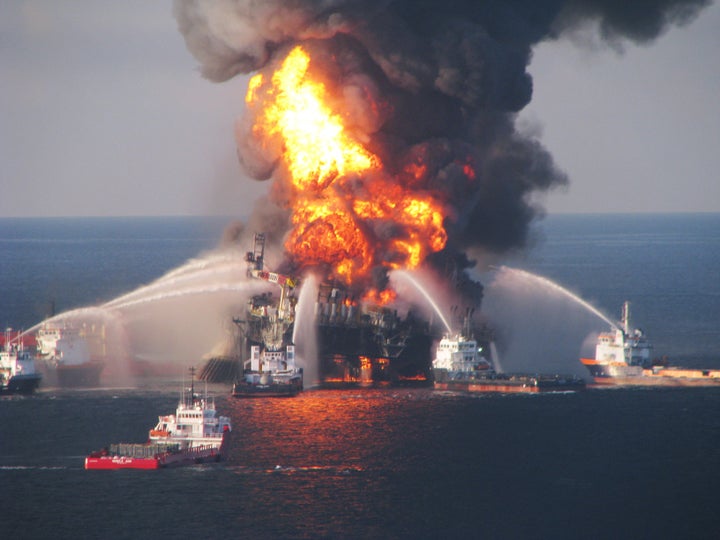
Executives from the three companies most implicated in the disastrous oil-rig explosion in the Gulf of Mexico will point fingers at each other Tuesday morning, according to the testimony they've prepared for a much-anticipated hearing of the Senate Energy & Natural Resources Committee.
Lamar McKay, president and chairman of BP America, will make a point of telling the committee that it wasn't actually BP's rig, stressing that the rig and its blowout preventer belonged to Transocean Limited.
Steven Newman, Transocean's president and CEO, will testify that his team was just doing what BP told them to do, how BP told them to do it -- and anyway it was subcontractor Halliburton's fault.
And Tim Probert, Halliburton's chief safety officer, will say that his company simply did what it was told, following industry practice. And he'll point out that Transocean, not Halliburton, was doing something when the rig blew.
BP's McKay (read the full text of his prepared statement here) portrays his company as something of a victim:
BP is one of the lease holders and the operator of this exploration well. As operator, BP hired Transocean to conduct the well drilling operations. Transocean owned the Deepwater Horizon drilling rig and its equipment, including the blowout preventer.
Only seven of the 126 people onboard the Deepwater Horizon were BP employees, McKay insists. So BP itself has "only some of the story" and is "working to piece together what happened from meticulous review of the records of rig operations that we have as well as information from those witnesses to whom we have access."
Here are the questions BP's McKay thinks are essential:
• What caused the explosion and fire?• And why did the blowout preventer fail?
Transocean's Newman, by contrast, thinks these are the key questions (read the full text of his prepared statement here):
Was the well properly designed? Was the well properly cemented? Were there problems with the well casing? Were all appropriate tests run on the cement and casings?
Newman, who will say he felt "compelled to respond" to some of the speculation about the cause of the accident, makes it clear how central BP (the "Operator") was to everything:
The Operator selects a driller (in this case, Transocean), which provides a vessel (called a "rig") from which drilling operations are performed.... The Operator's well plan dictates the manner in which the drilling is to occur, including the location, the path, the depth, the process and the testing. The drill bits, which are selected by the Operator, are supplied by another sub-contractor.A key element of the drilling process is drilling mud, a heavy fluid manufactured to the Operator's specifications. ...
In its well plan, the Operator specifies the diameter and strength of each casing segment, purchases the casing, and dictates how it will be cemented in place....
After drilling is concluded, yet another area of expertise comes into play. The cementing sub-contractor is responsible for encasing the well in cement, for putting a temporary cement plug in the top of the well, and for ensuring the integrity of the cement.... The cementing process is dictated by the Operator's well plan, and the testing of the cement on the Deepwater Horizon was performed by the cement contractor (Haliburton in this instance) as specified and directed by BP.
As for possible causes of the explosion itself, Transocean's Newman says, look to Halliburton:
What is most unusual about the explosion in this case is that it occurred after the well construction process was essentially finished. Drilling had been completed on April 17, and the well had been sealed with cement (to be reopened by the Operator at a later date if the Operator chose to put the well into production). ...Indeed, at the time of the explosion, the rig crew, at the direction of the Operator, was in the process of displacing drilling mud For that reason, the one thing we know with certainty is that on the evening of April 20, there was a sudden, catastrophic failure of the cement, the casing, or both. Therein lies the root cause of this occurrence; without a disastrous failure of one of those elements, the explosion could not have occurred.
Newman even goes so far as to call all the attention now being given to the blowout preventer -- the key fail-safe -- "somewhat ironic".
That's because "at the time of the explosion, the drilling process was complete. The well had been sealed with casing and cement, and within a few days, the [blowout preventers] would have been removed. At this point, the well barriers -- the cementing and the casing - were responsible for controlling any pressure from the reservoir."
Halliburton's Probert (read the full text of his prepared statement here) explains that his company was contracted by BP "to perform a variety of services." And he explains, in an "important statement of disclosure":
Halliburton, as a service provider to the well owner, is contractually bound to comply with the well owner's instructions on all matters relating to the performance of all work-related activities. It is also important to understand the roles and responsibilities of the various parties involved in the construction of a well. The construction of a deep water well is a complex operation involving the performance of numerous tasks by multiple parties led by the well owner's representative, who has the ultimate authority for decisions on how and when various activities are conducted...
There are many external factors that impact the design and execution of a cement job. These include the variability in the hole geometry, relative location of hydrocarbon zones, hydrocarbon content and the prior condition of the wellbore and associated fluids as determined by the drilling fluid provider. Casing strings are typically run with devices to centralize the casing concentrically in the wellbore and prevent incomplete displacement of drilling fluid, or "channeling".
While every effort is made to complete a cement job with the highest levels of mechanical and hydraulic integrity, the above mentioned well conditions may prevent this.
And Probert insists that Halliburton wasn't doing any cementing when the rig burst into flames. "Halliburton had completed the cementing of the ninth and final production casing string in accordance with the well program," he says. The last thing that happened before the explosion was Transocean's doing:
We understand that the drilling contractor then proceeded to displace the riser with seawater prior to the planned placement of the final cement plug, which would have been installed inside the production string and enabled the planned temporary abandonment of the well. Prior to the point in the well construction plan that the Halliburton personnel would have set the final cement plug, the catastrophic incident occurred. As a result, the final cement plug was never set.
Halliburton is confident that the cementing work... was completed in accordance with the requirements of the well owner's well construction plan.
/
